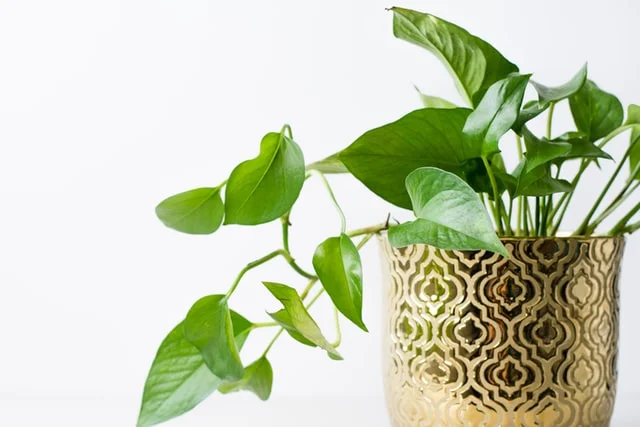Pothos is a modern vine that originates from Eastern India and the Solomon Islands. It can be found under several synonyms: Pothos aureus, Scindapsus aureus, and Epipremnum mooreense. It’s commonly known as Devil’s Ivy and Money Plant.
Pothos’ beautiful, thick, heart-shaped leaves come in different varieties: dark green, light green, or with golden and silver effects, slightly cracked on edge.
The plant is challenging and has aerial roots, which help Pothos absorb all humidity it needs.
You can water it once a week and even forget it for a couple of days, and it will still be alive. Yes, it will be alive, but it won’t be beautiful, bushy, and won’t have full appearance if you don’t give it what it needs.
Either you grow it in hanging baskets or a pot, like a vine, with support, whatever you like most, your Pothos must look healthy and rich in color and leaves.
If it looks leggy and sick, there must be something that you are not doing right. There are, indeed, some tips for you if you want to make your Pothos fuller!
- Light
- Fertiliser
- Water
- Humidity
- Pruning
- Pot size and transplantation in another pot
Table of Contents
LIGHT
Though light is one of the most important factors for beautiful and healthy plants, you must know that Pothos doesn’t like full light.
It can cause leaf burns, wilt, curl and ruin your plant. That’s one of the reasons that Pothos is one of the most common plants. There is no reason to put it directly at the window, especially for many plants that need full light.
You will easily find another one who will enjoy it. So, find a nice place, with indirect light, 50cm to 2m away from the window or full sunlight. But, be careful! Your leaves won’t be colorful in a dark place.
It will lose its typical patterns and become plane green. Plants that live in darker areas have more significant cracks and look like Monstera deliciosa.
If the plant doesn’t receive a minimal amount of light, it will produce small rear leaves, and the vines will look leggy. They just stretch towards the Sun, so give your plant enough light!
Artificial light may solve your problems if there is not enough natural light. There are different kinds of bulbs, but you should pick one with natural light.
Pothos likes temperatures between 17 and 30°(63 and 86°F), so it can be grown like a house plant in a moderate climate or outdoors in a tropical environment.
SOIL AND FERTILISER
Pothos likes light, well-drainaged soil, peat, and a little bit of tree bark and needs to be fertilized every three weeks.
There are various ways to do that:
- slow-release fertilizers usually stick or granules for green plants, which you put in a pot and forget about it for a more extended period of 3-6 months. Since the water melts it, this kind is useful for those who don’t have much time or are just lazy.
- water realize fertilizers are also simple to apply – mix it with water and add to your Pothos once in 3 weeks.
- foliar fertilizer – usually ready-to-use spray, but if you are not careful enough, it can cause leaves damage.
- organic and natural fertilizer:
- banana peel – rich in Potassium, Phosphorus, and Calcium, which makes your plant stronger, improves rooting, and helps in pest resistance. Simply chop up your banana peel, dig it into the soil, soak it in water, leave for a couple of days, and water your plants. Banana peel can be used to make your leaves look shiny if you have enough patience to brush each and one leaf with it.
- coffee ground is also a good way for fertilizing because it will add nitrogen to compost, improves drainage, and keep snails away.
- cracked eggshells – sink your eggshells in water and leave it for a day or two to realize all nutrients and use the liquid for watering, or simply grind eggshells with a mixer or just a hand and put it in the soil. It will improve the cell walls of your plant because it is full of calcium.
- yeast – put 10g of dry yeast per 10l of warm water and two tablespoons of sugar, leave for a couple of hours and water your Pothos 2-3 times during the season March – October.
WATER
Pothos doesn’t like much water. It’s enough to water it once a week when the soil is dry to the touch, but you must not use tap water.
Chlorine in water can cause burns, and your plants won’t grow as tall and robust as you want.
Leave the water for a day or two in a bin and let chlorine disappear. Or, simply boil the water, which also has its imperfections: you will kill all the minerals in tap water, which can help plants. It can also be seen in aquariums, placed on the top, with its roots growing freely in the water.
HUMIDITY
If you can provide 60% of humidity, you will be awarded big, shiny leaves. Aerial roots can absorb the moisture that the plant needs from the air. It also reduces indoor pollution.
PRUNING
Pothos can grow 3m in the house and even 15m outdoors, but if you don’t follow previous tips, it won’t be bushy and won’t have a fuller look. You don’t want your plant to have rear leaves and naked stalks.
So… Don’t be too sensitive. As soon as you see that it doesn’t look the way you want, get your gardening shares and cut about 1cm above the leaf.
A new leaf needs some space to grow, so ensure that you do not cut it too close to the old one.
Do it with all branches, and it will thank you for bigger and shinier leaves. Also, cut all leafless vines completely because they will never regrow.
The best period for pruning is spring. Everything you cut, you can re-use to make other plants. Put the 10-15cm long cuttings in a jar with water.
Store it in a warm, dark place because, roots will slowly develop in a light place. Safer way is to put it in the soil. It will soon start to root.
POT SIZE AND TRANSPLANTATION
Pothos doesn’t need to be moved very often. You should move it for the first time in a new pot 6 months after buying. When you notice that the roots are peeking from the pot, get another.
You should take care that the new pot mustn’t be much bigger than the previous one. That’s the way that you can avoid your root get bigger and your leaves fall behind. Every two years is a good period for replanting.
Hanging baskets with Pothos look amazing! You can plant several cuttings in the circle and one in the inside of the pot and let it grow.
Pothos doesn’t have big root systems, so it will nicely grow together. If you put different types of Pothos together, you will have fuller, colorful plants to enjoy in. Take care of it and very soon you will have a huge, healthy ball of nice, green leaves.
If it is oversized, use your shares again, mark the vines you want to cut, and cut it. It will grow stronger and bushier.
In the summer, you can hang your baskets in front of your Northern or Eastern porch or a balcony, in the shade or partial shade, and enjoy all that fabulous look.
For the full effect, make sure that the color of your pots goes well with the color of the leaves.
Pothos can be very well grown as a vine, too. It needs support as it originates from the jungles where it winds around very tall trees.
So, give your plant natural conditions, as much as you can. Let it wind around trailers, but do not forget to prune it anyway, so it doesn’t become leggy.
You should put the support as soon as you plant your Pothos, so it feels free to grow. The best solution may be a moss pole.
You can plant several plants in the pot and put it wind around the pole with wet moss. It will help aerial roots get enough humidity that they need. Also, you can use bamboo canes and make a trellis, or use some other trellises.
Everything that comes to your mind and that can hold it because when the plant is healthy, it has big, heavy leaves and needs good support to climb.
Toxicity
Pothos is listed as toxic to dogs and cats, so you must ensure it in the order it is not consumed by them. It causes difficulty in swallowing and oral irritation.
It is also slightly toxic to humans as well and can cause eczema and skin irritation.
conclusion
Despite that, Pothos is really grateful plant that doesn’t need too much care, so give it a try and don’t doubt – if you give it adequate light, nutritive soil, enough water, and heavy pruning now and then, it will be the best green wall and beautiful decoration in your home.
Photo by Kelsey Brown on Unsplash


